SBM 1300 Research Proposal: Perth Arena Project Analysis
VerifiedAdded on 2022/11/15
|27
|5784
|8
Project
AI Summary
This research proposal, submitted to Desklib, investigates the critical success factors of the Perth Arena construction project in Australia. The study aims to identify factors contributing to project success and delays, particularly focusing on time and cost overruns. The methodology includes both quantitative and qualitative data collection through surveys and interviews with construction managers and employees. A literature review establishes the background, objectives, and research questions, exploring the correlation between cost and delay factors and the project's success. The proposal outlines the use of regression analysis to analyze collected data and develop hypotheses. Findings from the literature suggest that improper governance structures and lack of top management support contribute to project issues. The research recommends effective project team motivation, efficient management practices, and improved planning skills. Keywords such as critical success factors, project delay, time, cost, and construction project are central to the analysis.
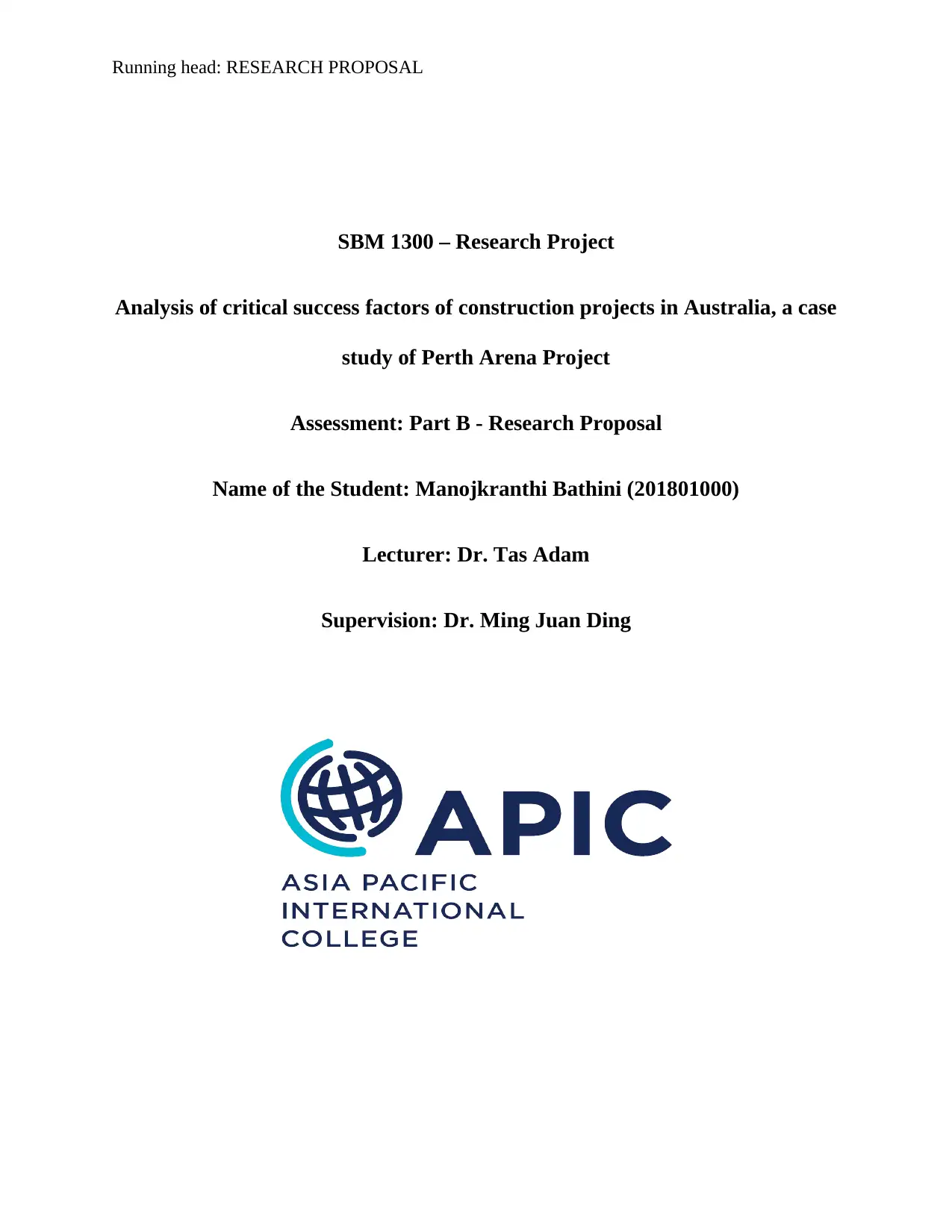
Running head: RESEARCH PROPOSAL
SBM 1300 – Research Project
Analysis of critical success factors of construction projects in Australia, a case
study of Perth Arena Project
Assessment: Part B - Research Proposal
Name of the Student: Manojkranthi Bathini (201801000)
Lecturer: Dr. Tas Adam
Supervision: Dr. Ming Juan Ding
SBM 1300 – Research Project
Analysis of critical success factors of construction projects in Australia, a case
study of Perth Arena Project
Assessment: Part B - Research Proposal
Name of the Student: Manojkranthi Bathini (201801000)
Lecturer: Dr. Tas Adam
Supervision: Dr. Ming Juan Ding
Paraphrase This Document
Need a fresh take? Get an instant paraphrase of this document with our AI Paraphraser
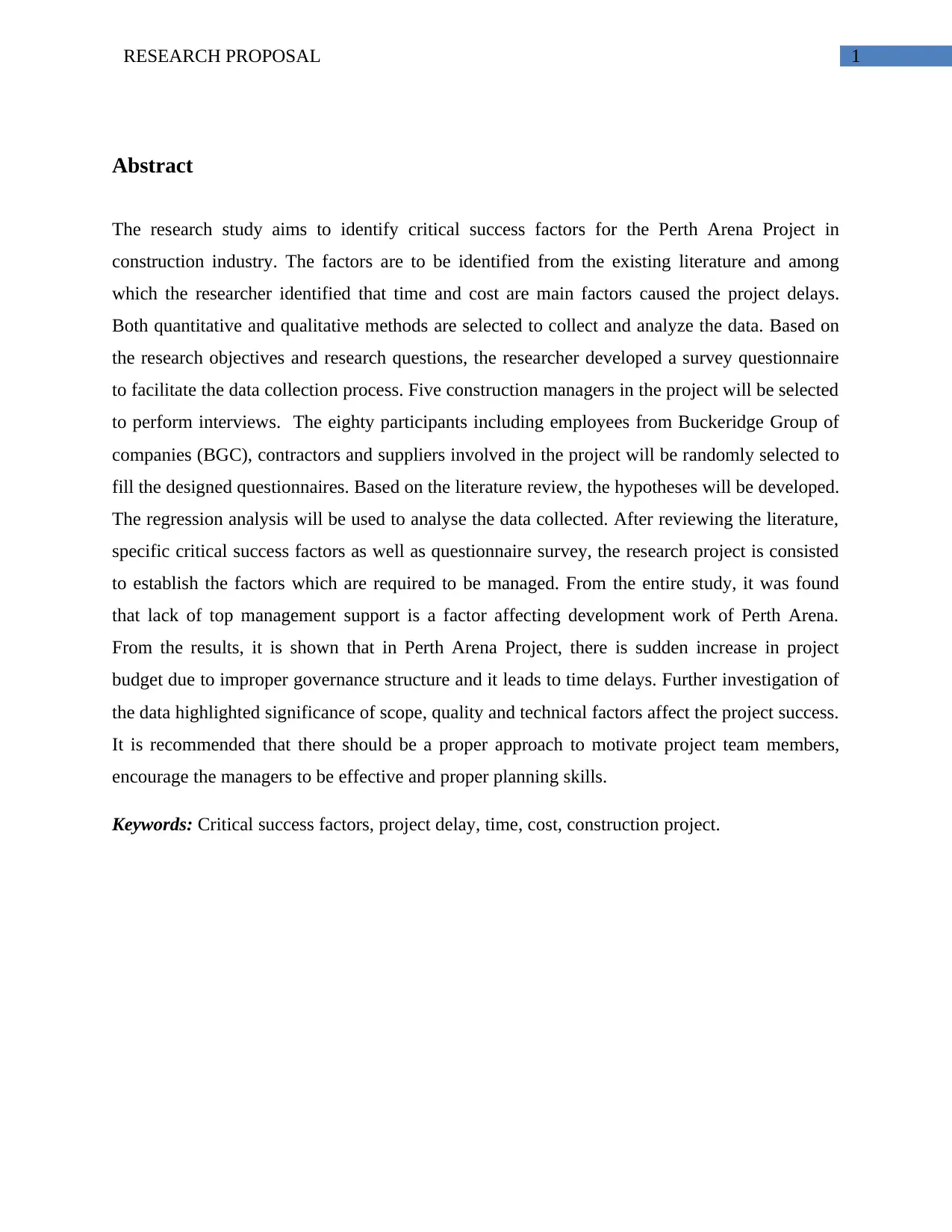
1RESEARCH PROPOSAL
Abstract
The research study aims to identify critical success factors for the Perth Arena Project in
construction industry. The factors are to be identified from the existing literature and among
which the researcher identified that time and cost are main factors caused the project delays.
Both quantitative and qualitative methods are selected to collect and analyze the data. Based on
the research objectives and research questions, the researcher developed a survey questionnaire
to facilitate the data collection process. Five construction managers in the project will be selected
to perform interviews. The eighty participants including employees from Buckeridge Group of
companies (BGC), contractors and suppliers involved in the project will be randomly selected to
fill the designed questionnaires. Based on the literature review, the hypotheses will be developed.
The regression analysis will be used to analyse the data collected. After reviewing the literature,
specific critical success factors as well as questionnaire survey, the research project is consisted
to establish the factors which are required to be managed. From the entire study, it was found
that lack of top management support is a factor affecting development work of Perth Arena.
From the results, it is shown that in Perth Arena Project, there is sudden increase in project
budget due to improper governance structure and it leads to time delays. Further investigation of
the data highlighted significance of scope, quality and technical factors affect the project success.
It is recommended that there should be a proper approach to motivate project team members,
encourage the managers to be effective and proper planning skills.
Keywords: Critical success factors, project delay, time, cost, construction project.
Abstract
The research study aims to identify critical success factors for the Perth Arena Project in
construction industry. The factors are to be identified from the existing literature and among
which the researcher identified that time and cost are main factors caused the project delays.
Both quantitative and qualitative methods are selected to collect and analyze the data. Based on
the research objectives and research questions, the researcher developed a survey questionnaire
to facilitate the data collection process. Five construction managers in the project will be selected
to perform interviews. The eighty participants including employees from Buckeridge Group of
companies (BGC), contractors and suppliers involved in the project will be randomly selected to
fill the designed questionnaires. Based on the literature review, the hypotheses will be developed.
The regression analysis will be used to analyse the data collected. After reviewing the literature,
specific critical success factors as well as questionnaire survey, the research project is consisted
to establish the factors which are required to be managed. From the entire study, it was found
that lack of top management support is a factor affecting development work of Perth Arena.
From the results, it is shown that in Perth Arena Project, there is sudden increase in project
budget due to improper governance structure and it leads to time delays. Further investigation of
the data highlighted significance of scope, quality and technical factors affect the project success.
It is recommended that there should be a proper approach to motivate project team members,
encourage the managers to be effective and proper planning skills.
Keywords: Critical success factors, project delay, time, cost, construction project.
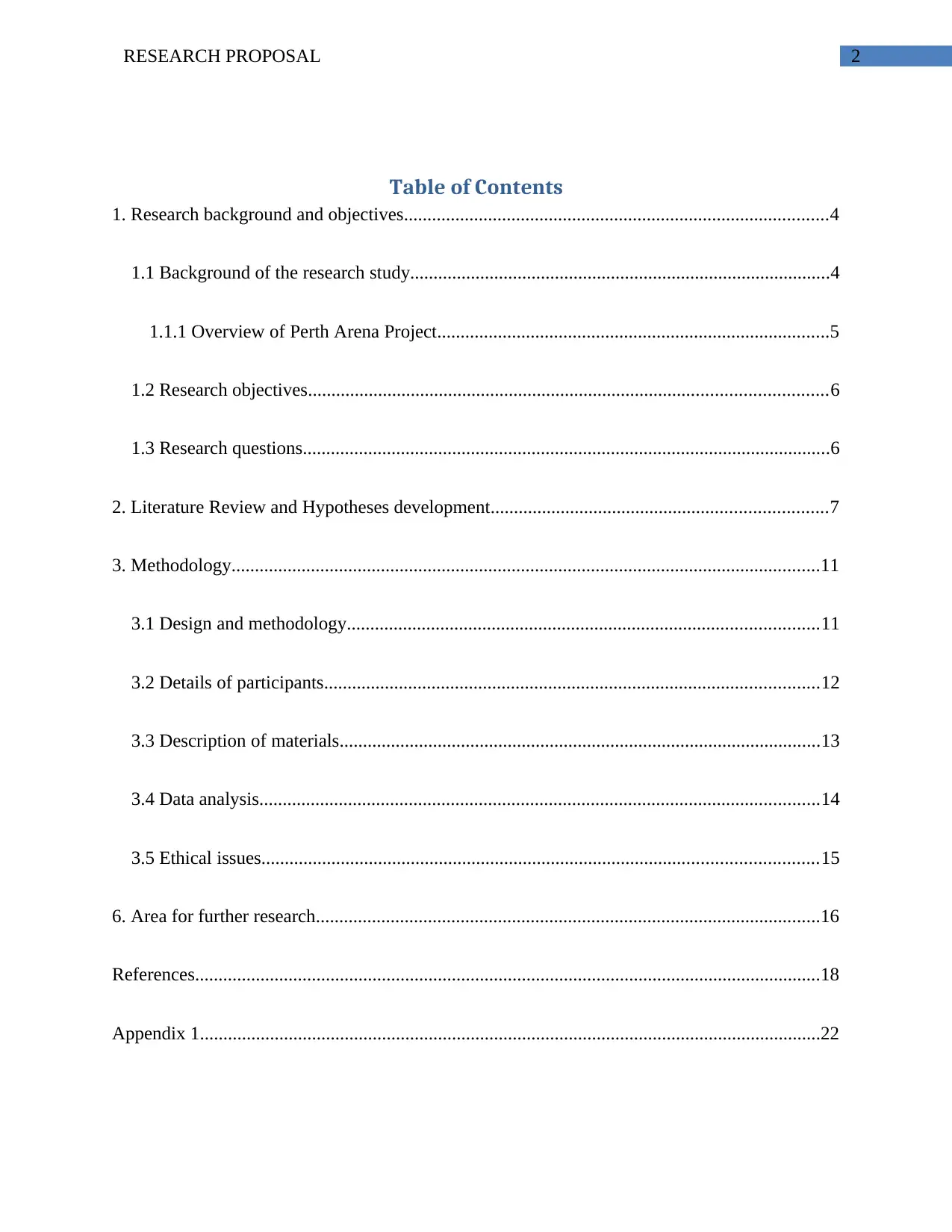
2RESEARCH PROPOSAL
Table of Contents
1. Research background and objectives...........................................................................................4
1.1 Background of the research study..........................................................................................4
1.1.1 Overview of Perth Arena Project....................................................................................5
1.2 Research objectives...............................................................................................................6
1.3 Research questions.................................................................................................................6
2. Literature Review and Hypotheses development........................................................................7
3. Methodology..............................................................................................................................11
3.1 Design and methodology.....................................................................................................11
3.2 Details of participants..........................................................................................................12
3.3 Description of materials.......................................................................................................13
3.4 Data analysis........................................................................................................................14
3.5 Ethical issues.......................................................................................................................15
6. Area for further research............................................................................................................16
References......................................................................................................................................18
Appendix 1.....................................................................................................................................22
Table of Contents
1. Research background and objectives...........................................................................................4
1.1 Background of the research study..........................................................................................4
1.1.1 Overview of Perth Arena Project....................................................................................5
1.2 Research objectives...............................................................................................................6
1.3 Research questions.................................................................................................................6
2. Literature Review and Hypotheses development........................................................................7
3. Methodology..............................................................................................................................11
3.1 Design and methodology.....................................................................................................11
3.2 Details of participants..........................................................................................................12
3.3 Description of materials.......................................................................................................13
3.4 Data analysis........................................................................................................................14
3.5 Ethical issues.......................................................................................................................15
6. Area for further research............................................................................................................16
References......................................................................................................................................18
Appendix 1.....................................................................................................................................22
⊘ This is a preview!⊘
Do you want full access?
Subscribe today to unlock all pages.

Trusted by 1+ million students worldwide
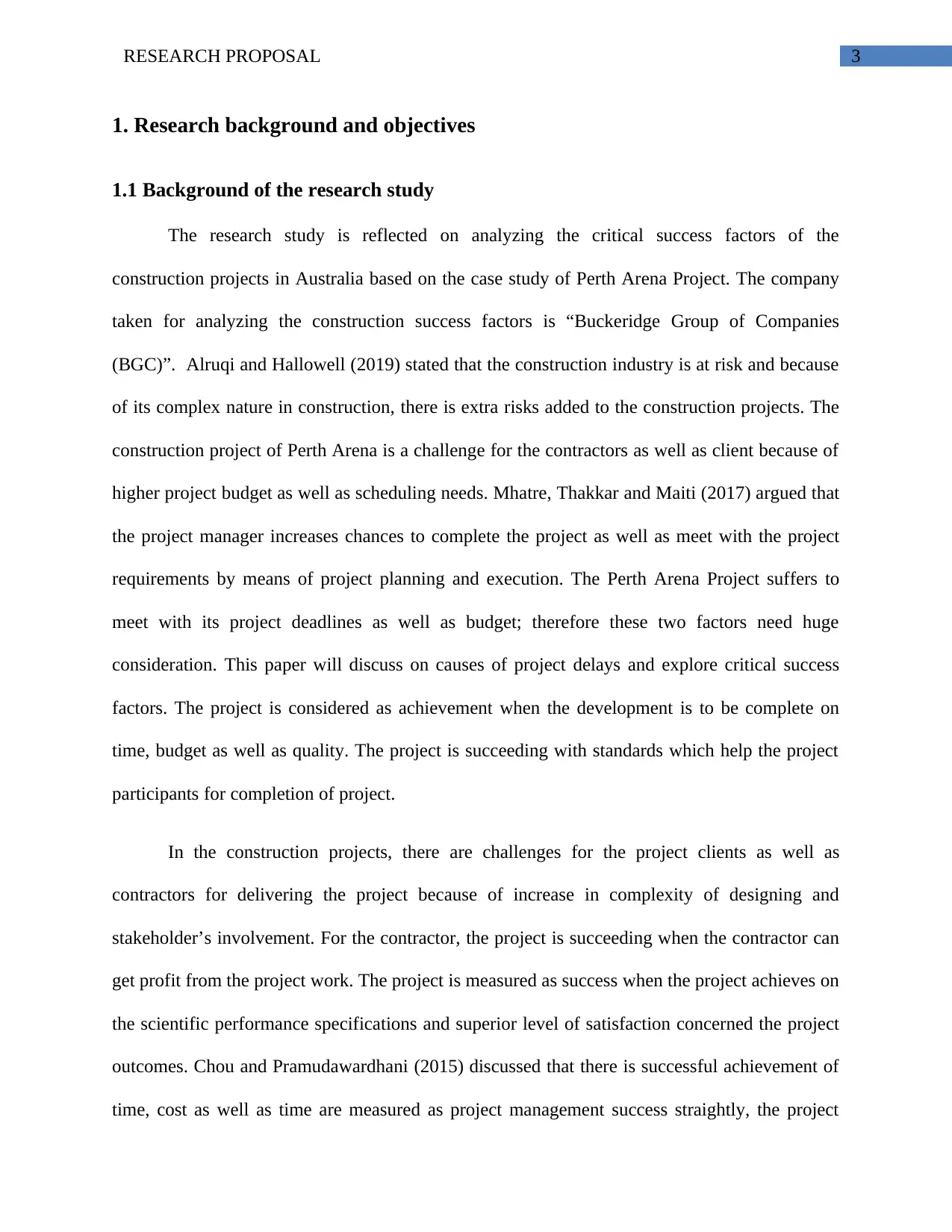
3RESEARCH PROPOSAL
1. Research background and objectives
1.1 Background of the research study
The research study is reflected on analyzing the critical success factors of the
construction projects in Australia based on the case study of Perth Arena Project. The company
taken for analyzing the construction success factors is “Buckeridge Group of Companies
(BGC)”. Alruqi and Hallowell (2019) stated that the construction industry is at risk and because
of its complex nature in construction, there is extra risks added to the construction projects. The
construction project of Perth Arena is a challenge for the contractors as well as client because of
higher project budget as well as scheduling needs. Mhatre, Thakkar and Maiti (2017) argued that
the project manager increases chances to complete the project as well as meet with the project
requirements by means of project planning and execution. The Perth Arena Project suffers to
meet with its project deadlines as well as budget; therefore these two factors need huge
consideration. This paper will discuss on causes of project delays and explore critical success
factors. The project is considered as achievement when the development is to be complete on
time, budget as well as quality. The project is succeeding with standards which help the project
participants for completion of project.
In the construction projects, there are challenges for the project clients as well as
contractors for delivering the project because of increase in complexity of designing and
stakeholder’s involvement. For the contractor, the project is succeeding when the contractor can
get profit from the project work. The project is measured as success when the project achieves on
the scientific performance specifications and superior level of satisfaction concerned the project
outcomes. Chou and Pramudawardhani (2015) discussed that there is successful achievement of
time, cost as well as time are measured as project management success straightly, the project
1. Research background and objectives
1.1 Background of the research study
The research study is reflected on analyzing the critical success factors of the
construction projects in Australia based on the case study of Perth Arena Project. The company
taken for analyzing the construction success factors is “Buckeridge Group of Companies
(BGC)”. Alruqi and Hallowell (2019) stated that the construction industry is at risk and because
of its complex nature in construction, there is extra risks added to the construction projects. The
construction project of Perth Arena is a challenge for the contractors as well as client because of
higher project budget as well as scheduling needs. Mhatre, Thakkar and Maiti (2017) argued that
the project manager increases chances to complete the project as well as meet with the project
requirements by means of project planning and execution. The Perth Arena Project suffers to
meet with its project deadlines as well as budget; therefore these two factors need huge
consideration. This paper will discuss on causes of project delays and explore critical success
factors. The project is considered as achievement when the development is to be complete on
time, budget as well as quality. The project is succeeding with standards which help the project
participants for completion of project.
In the construction projects, there are challenges for the project clients as well as
contractors for delivering the project because of increase in complexity of designing and
stakeholder’s involvement. For the contractor, the project is succeeding when the contractor can
get profit from the project work. The project is measured as success when the project achieves on
the scientific performance specifications and superior level of satisfaction concerned the project
outcomes. Chou and Pramudawardhani (2015) discussed that there is successful achievement of
time, cost as well as time are measured as project management success straightly, the project
Paraphrase This Document
Need a fresh take? Get an instant paraphrase of this document with our AI Paraphraser
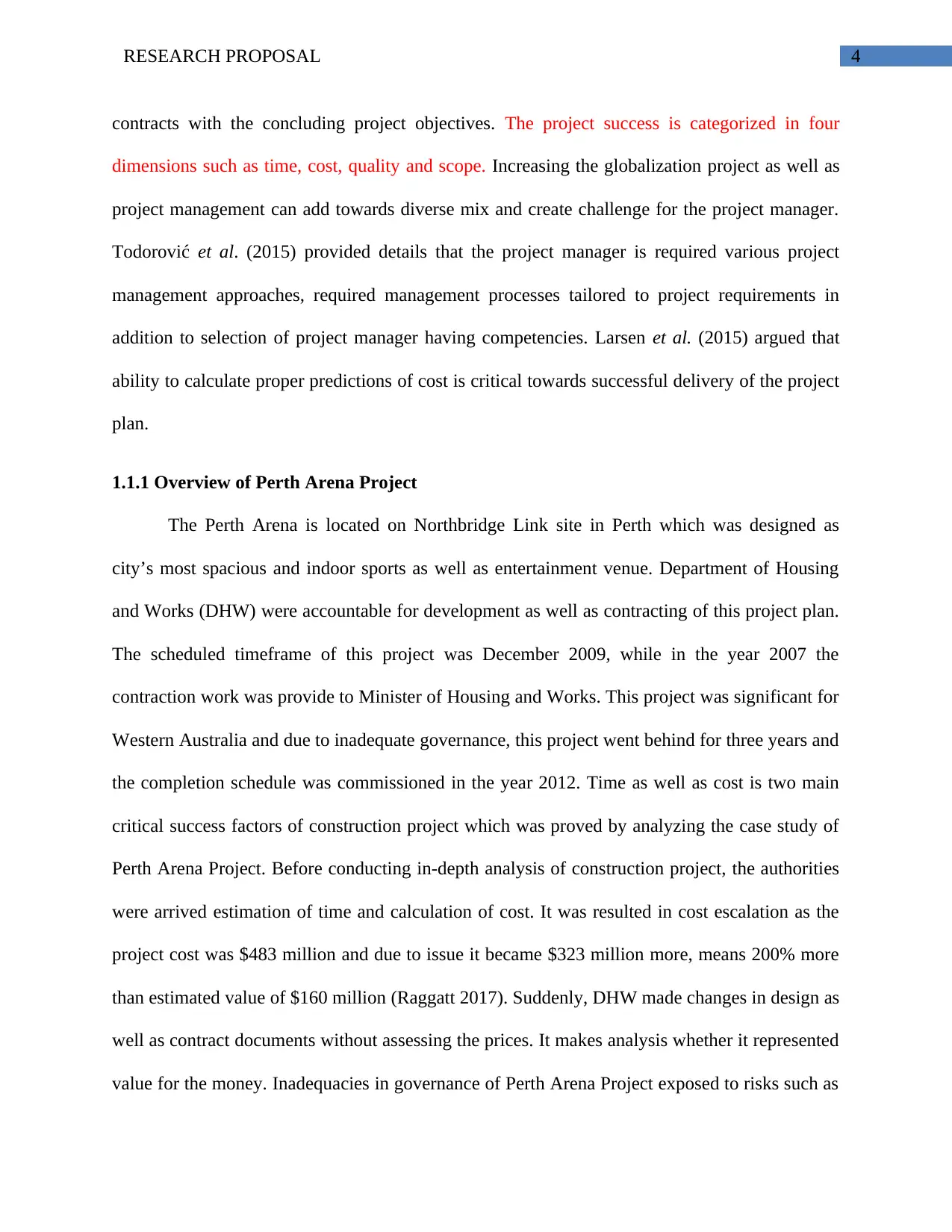
4RESEARCH PROPOSAL
contracts with the concluding project objectives. The project success is categorized in four
dimensions such as time, cost, quality and scope. Increasing the globalization project as well as
project management can add towards diverse mix and create challenge for the project manager.
Todorović et al. (2015) provided details that the project manager is required various project
management approaches, required management processes tailored to project requirements in
addition to selection of project manager having competencies. Larsen et al. (2015) argued that
ability to calculate proper predictions of cost is critical towards successful delivery of the project
plan.
1.1.1 Overview of Perth Arena Project
The Perth Arena is located on Northbridge Link site in Perth which was designed as
city’s most spacious and indoor sports as well as entertainment venue. Department of Housing
and Works (DHW) were accountable for development as well as contracting of this project plan.
The scheduled timeframe of this project was December 2009, while in the year 2007 the
contraction work was provide to Minister of Housing and Works. This project was significant for
Western Australia and due to inadequate governance, this project went behind for three years and
the completion schedule was commissioned in the year 2012. Time as well as cost is two main
critical success factors of construction project which was proved by analyzing the case study of
Perth Arena Project. Before conducting in-depth analysis of construction project, the authorities
were arrived estimation of time and calculation of cost. It was resulted in cost escalation as the
project cost was $483 million and due to issue it became $323 million more, means 200% more
than estimated value of $160 million (Raggatt 2017). Suddenly, DHW made changes in design as
well as contract documents without assessing the prices. It makes analysis whether it represented
value for the money. Inadequacies in governance of Perth Arena Project exposed to risks such as
contracts with the concluding project objectives. The project success is categorized in four
dimensions such as time, cost, quality and scope. Increasing the globalization project as well as
project management can add towards diverse mix and create challenge for the project manager.
Todorović et al. (2015) provided details that the project manager is required various project
management approaches, required management processes tailored to project requirements in
addition to selection of project manager having competencies. Larsen et al. (2015) argued that
ability to calculate proper predictions of cost is critical towards successful delivery of the project
plan.
1.1.1 Overview of Perth Arena Project
The Perth Arena is located on Northbridge Link site in Perth which was designed as
city’s most spacious and indoor sports as well as entertainment venue. Department of Housing
and Works (DHW) were accountable for development as well as contracting of this project plan.
The scheduled timeframe of this project was December 2009, while in the year 2007 the
contraction work was provide to Minister of Housing and Works. This project was significant for
Western Australia and due to inadequate governance, this project went behind for three years and
the completion schedule was commissioned in the year 2012. Time as well as cost is two main
critical success factors of construction project which was proved by analyzing the case study of
Perth Arena Project. Before conducting in-depth analysis of construction project, the authorities
were arrived estimation of time and calculation of cost. It was resulted in cost escalation as the
project cost was $483 million and due to issue it became $323 million more, means 200% more
than estimated value of $160 million (Raggatt 2017). Suddenly, DHW made changes in design as
well as contract documents without assessing the prices. It makes analysis whether it represented
value for the money. Inadequacies in governance of Perth Arena Project exposed to risks such as
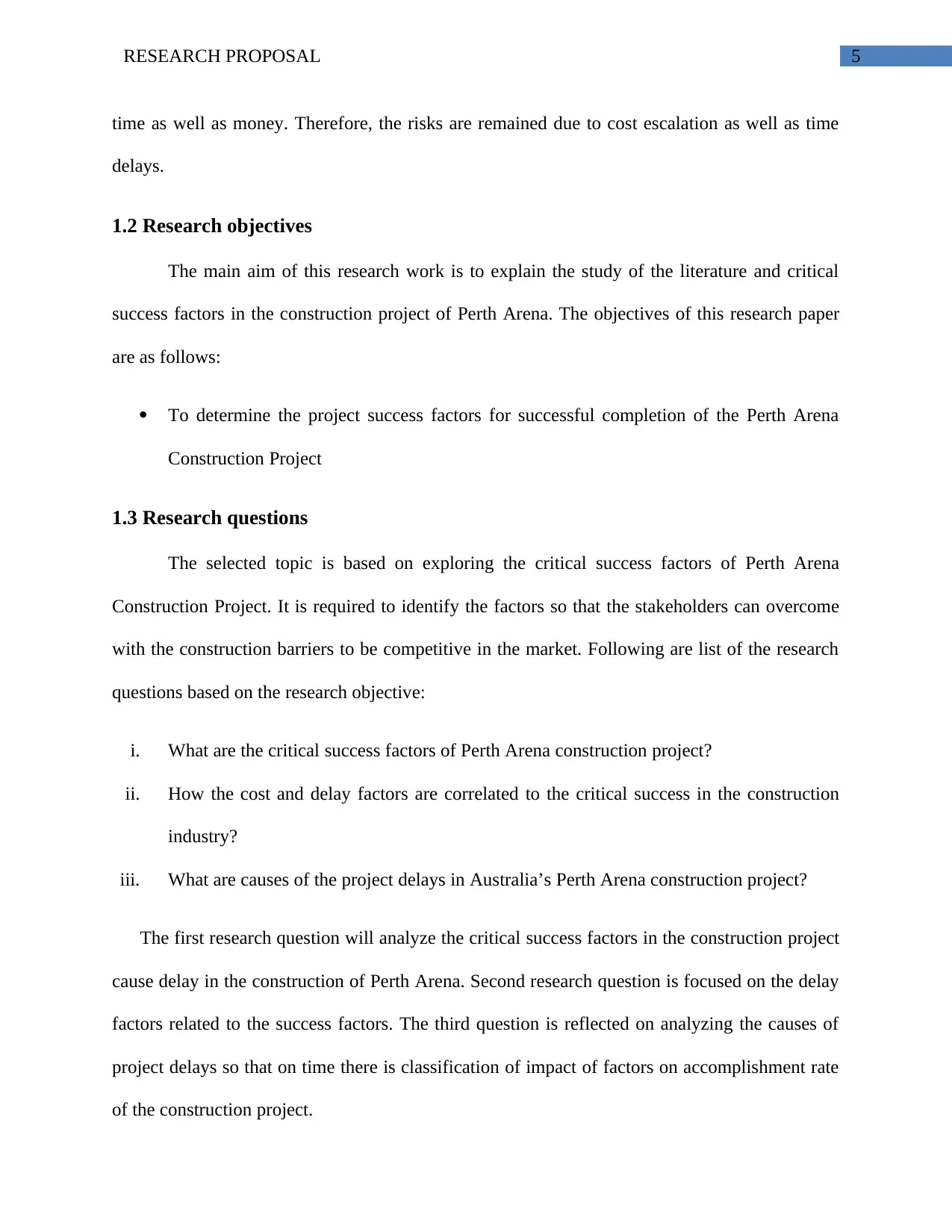
5RESEARCH PROPOSAL
time as well as money. Therefore, the risks are remained due to cost escalation as well as time
delays.
1.2 Research objectives
The main aim of this research work is to explain the study of the literature and critical
success factors in the construction project of Perth Arena. The objectives of this research paper
are as follows:
To determine the project success factors for successful completion of the Perth Arena
Construction Project
1.3 Research questions
The selected topic is based on exploring the critical success factors of Perth Arena
Construction Project. It is required to identify the factors so that the stakeholders can overcome
with the construction barriers to be competitive in the market. Following are list of the research
questions based on the research objective:
i. What are the critical success factors of Perth Arena construction project?
ii. How the cost and delay factors are correlated to the critical success in the construction
industry?
iii. What are causes of the project delays in Australia’s Perth Arena construction project?
The first research question will analyze the critical success factors in the construction project
cause delay in the construction of Perth Arena. Second research question is focused on the delay
factors related to the success factors. The third question is reflected on analyzing the causes of
project delays so that on time there is classification of impact of factors on accomplishment rate
of the construction project.
time as well as money. Therefore, the risks are remained due to cost escalation as well as time
delays.
1.2 Research objectives
The main aim of this research work is to explain the study of the literature and critical
success factors in the construction project of Perth Arena. The objectives of this research paper
are as follows:
To determine the project success factors for successful completion of the Perth Arena
Construction Project
1.3 Research questions
The selected topic is based on exploring the critical success factors of Perth Arena
Construction Project. It is required to identify the factors so that the stakeholders can overcome
with the construction barriers to be competitive in the market. Following are list of the research
questions based on the research objective:
i. What are the critical success factors of Perth Arena construction project?
ii. How the cost and delay factors are correlated to the critical success in the construction
industry?
iii. What are causes of the project delays in Australia’s Perth Arena construction project?
The first research question will analyze the critical success factors in the construction project
cause delay in the construction of Perth Arena. Second research question is focused on the delay
factors related to the success factors. The third question is reflected on analyzing the causes of
project delays so that on time there is classification of impact of factors on accomplishment rate
of the construction project.
⊘ This is a preview!⊘
Do you want full access?
Subscribe today to unlock all pages.

Trusted by 1+ million students worldwide
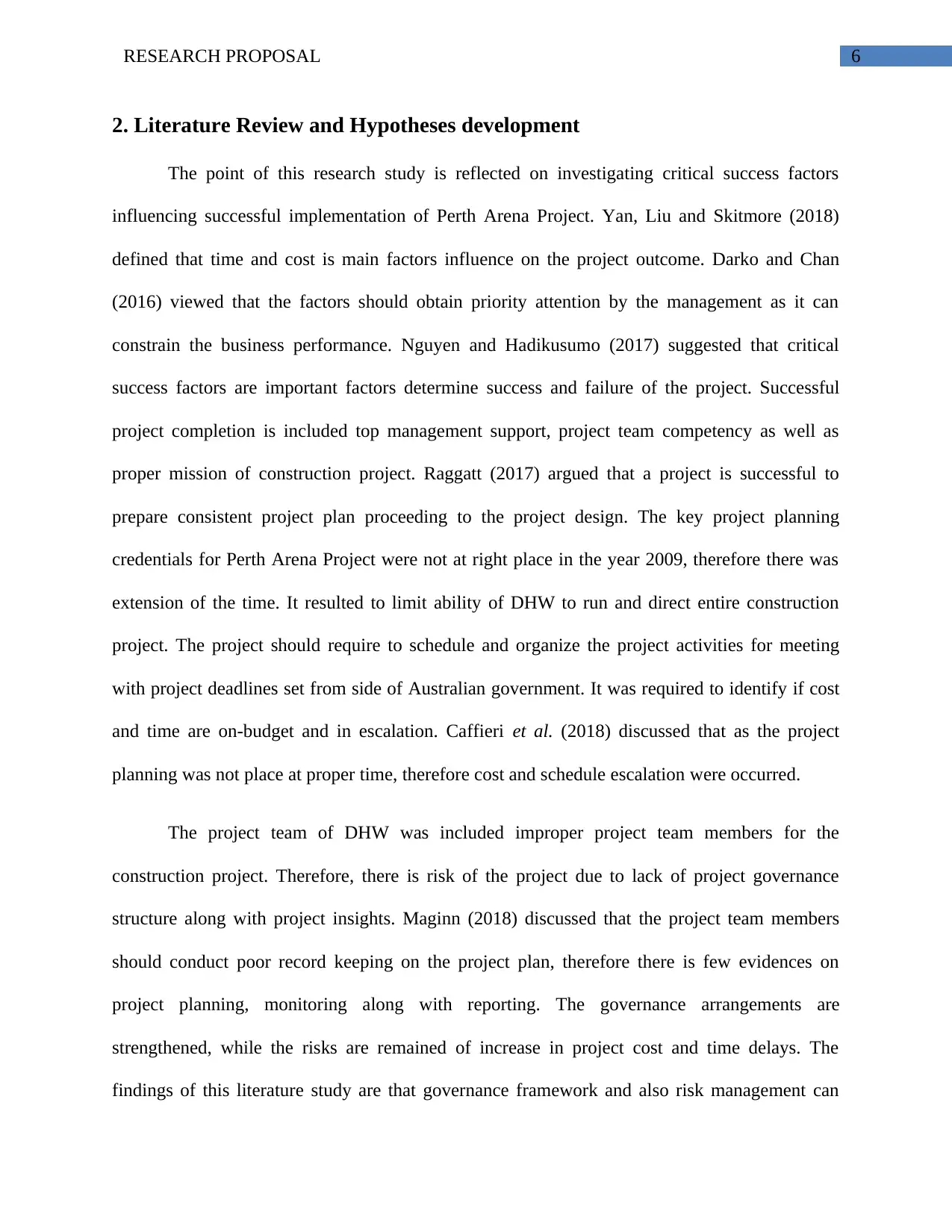
6RESEARCH PROPOSAL
2. Literature Review and Hypotheses development
The point of this research study is reflected on investigating critical success factors
influencing successful implementation of Perth Arena Project. Yan, Liu and Skitmore (2018)
defined that time and cost is main factors influence on the project outcome. Darko and Chan
(2016) viewed that the factors should obtain priority attention by the management as it can
constrain the business performance. Nguyen and Hadikusumo (2017) suggested that critical
success factors are important factors determine success and failure of the project. Successful
project completion is included top management support, project team competency as well as
proper mission of construction project. Raggatt (2017) argued that a project is successful to
prepare consistent project plan proceeding to the project design. The key project planning
credentials for Perth Arena Project were not at right place in the year 2009, therefore there was
extension of the time. It resulted to limit ability of DHW to run and direct entire construction
project. The project should require to schedule and organize the project activities for meeting
with project deadlines set from side of Australian government. It was required to identify if cost
and time are on-budget and in escalation. Caffieri et al. (2018) discussed that as the project
planning was not place at proper time, therefore cost and schedule escalation were occurred.
The project team of DHW was included improper project team members for the
construction project. Therefore, there is risk of the project due to lack of project governance
structure along with project insights. Maginn (2018) discussed that the project team members
should conduct poor record keeping on the project plan, therefore there is few evidences on
project planning, monitoring along with reporting. The governance arrangements are
strengthened, while the risks are remained of increase in project cost and time delays. The
findings of this literature study are that governance framework and also risk management can
2. Literature Review and Hypotheses development
The point of this research study is reflected on investigating critical success factors
influencing successful implementation of Perth Arena Project. Yan, Liu and Skitmore (2018)
defined that time and cost is main factors influence on the project outcome. Darko and Chan
(2016) viewed that the factors should obtain priority attention by the management as it can
constrain the business performance. Nguyen and Hadikusumo (2017) suggested that critical
success factors are important factors determine success and failure of the project. Successful
project completion is included top management support, project team competency as well as
proper mission of construction project. Raggatt (2017) argued that a project is successful to
prepare consistent project plan proceeding to the project design. The key project planning
credentials for Perth Arena Project were not at right place in the year 2009, therefore there was
extension of the time. It resulted to limit ability of DHW to run and direct entire construction
project. The project should require to schedule and organize the project activities for meeting
with project deadlines set from side of Australian government. It was required to identify if cost
and time are on-budget and in escalation. Caffieri et al. (2018) discussed that as the project
planning was not place at proper time, therefore cost and schedule escalation were occurred.
The project team of DHW was included improper project team members for the
construction project. Therefore, there is risk of the project due to lack of project governance
structure along with project insights. Maginn (2018) discussed that the project team members
should conduct poor record keeping on the project plan, therefore there is few evidences on
project planning, monitoring along with reporting. The governance arrangements are
strengthened, while the risks are remained of increase in project cost and time delays. The
findings of this literature study are that governance framework and also risk management can
Paraphrase This Document
Need a fresh take? Get an instant paraphrase of this document with our AI Paraphraser
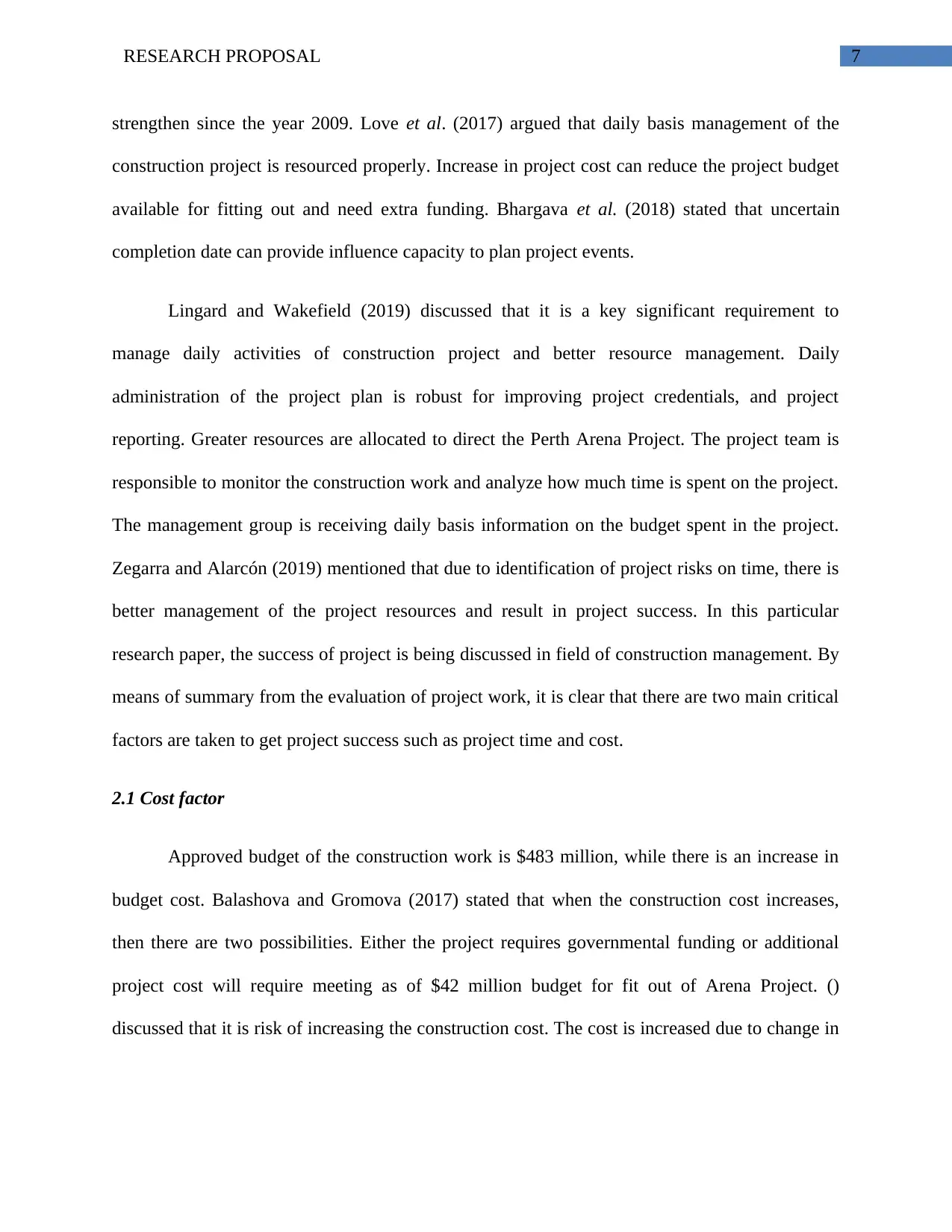
7RESEARCH PROPOSAL
strengthen since the year 2009. Love et al. (2017) argued that daily basis management of the
construction project is resourced properly. Increase in project cost can reduce the project budget
available for fitting out and need extra funding. Bhargava et al. (2018) stated that uncertain
completion date can provide influence capacity to plan project events.
Lingard and Wakefield (2019) discussed that it is a key significant requirement to
manage daily activities of construction project and better resource management. Daily
administration of the project plan is robust for improving project credentials, and project
reporting. Greater resources are allocated to direct the Perth Arena Project. The project team is
responsible to monitor the construction work and analyze how much time is spent on the project.
The management group is receiving daily basis information on the budget spent in the project.
Zegarra and Alarcón (2019) mentioned that due to identification of project risks on time, there is
better management of the project resources and result in project success. In this particular
research paper, the success of project is being discussed in field of construction management. By
means of summary from the evaluation of project work, it is clear that there are two main critical
factors are taken to get project success such as project time and cost.
2.1 Cost factor
Approved budget of the construction work is $483 million, while there is an increase in
budget cost. Balashova and Gromova (2017) stated that when the construction cost increases,
then there are two possibilities. Either the project requires governmental funding or additional
project cost will require meeting as of $42 million budget for fit out of Arena Project. ()
discussed that it is risk of increasing the construction cost. The cost is increased due to change in
strengthen since the year 2009. Love et al. (2017) argued that daily basis management of the
construction project is resourced properly. Increase in project cost can reduce the project budget
available for fitting out and need extra funding. Bhargava et al. (2018) stated that uncertain
completion date can provide influence capacity to plan project events.
Lingard and Wakefield (2019) discussed that it is a key significant requirement to
manage daily activities of construction project and better resource management. Daily
administration of the project plan is robust for improving project credentials, and project
reporting. Greater resources are allocated to direct the Perth Arena Project. The project team is
responsible to monitor the construction work and analyze how much time is spent on the project.
The management group is receiving daily basis information on the budget spent in the project.
Zegarra and Alarcón (2019) mentioned that due to identification of project risks on time, there is
better management of the project resources and result in project success. In this particular
research paper, the success of project is being discussed in field of construction management. By
means of summary from the evaluation of project work, it is clear that there are two main critical
factors are taken to get project success such as project time and cost.
2.1 Cost factor
Approved budget of the construction work is $483 million, while there is an increase in
budget cost. Balashova and Gromova (2017) stated that when the construction cost increases,
then there are two possibilities. Either the project requires governmental funding or additional
project cost will require meeting as of $42 million budget for fit out of Arena Project. ()
discussed that it is risk of increasing the construction cost. The cost is increased due to change in
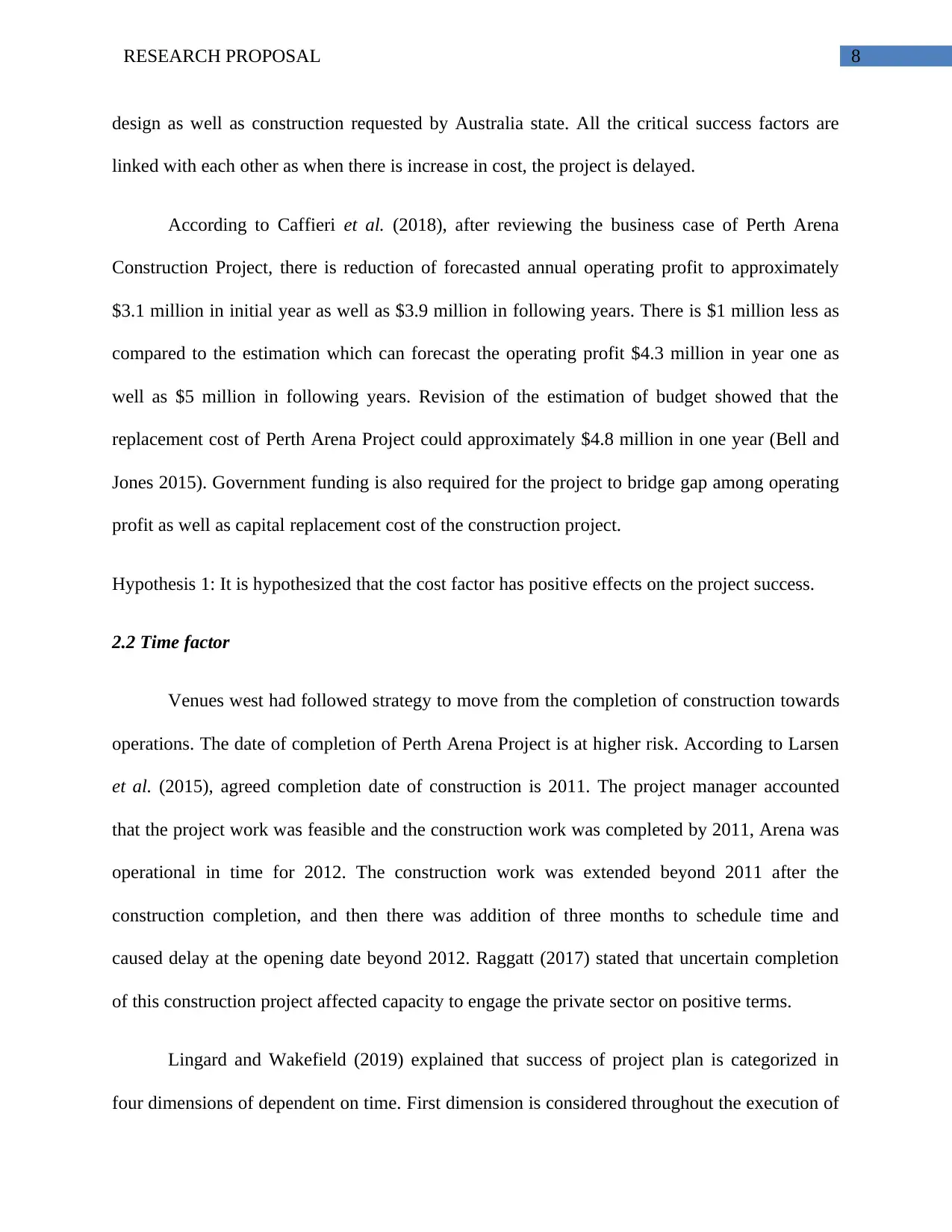
8RESEARCH PROPOSAL
design as well as construction requested by Australia state. All the critical success factors are
linked with each other as when there is increase in cost, the project is delayed.
According to Caffieri et al. (2018), after reviewing the business case of Perth Arena
Construction Project, there is reduction of forecasted annual operating profit to approximately
$3.1 million in initial year as well as $3.9 million in following years. There is $1 million less as
compared to the estimation which can forecast the operating profit $4.3 million in year one as
well as $5 million in following years. Revision of the estimation of budget showed that the
replacement cost of Perth Arena Project could approximately $4.8 million in one year (Bell and
Jones 2015). Government funding is also required for the project to bridge gap among operating
profit as well as capital replacement cost of the construction project.
Hypothesis 1: It is hypothesized that the cost factor has positive effects on the project success.
2.2 Time factor
Venues west had followed strategy to move from the completion of construction towards
operations. The date of completion of Perth Arena Project is at higher risk. According to Larsen
et al. (2015), agreed completion date of construction is 2011. The project manager accounted
that the project work was feasible and the construction work was completed by 2011, Arena was
operational in time for 2012. The construction work was extended beyond 2011 after the
construction completion, and then there was addition of three months to schedule time and
caused delay at the opening date beyond 2012. Raggatt (2017) stated that uncertain completion
of this construction project affected capacity to engage the private sector on positive terms.
Lingard and Wakefield (2019) explained that success of project plan is categorized in
four dimensions of dependent on time. First dimension is considered throughout the execution of
design as well as construction requested by Australia state. All the critical success factors are
linked with each other as when there is increase in cost, the project is delayed.
According to Caffieri et al. (2018), after reviewing the business case of Perth Arena
Construction Project, there is reduction of forecasted annual operating profit to approximately
$3.1 million in initial year as well as $3.9 million in following years. There is $1 million less as
compared to the estimation which can forecast the operating profit $4.3 million in year one as
well as $5 million in following years. Revision of the estimation of budget showed that the
replacement cost of Perth Arena Project could approximately $4.8 million in one year (Bell and
Jones 2015). Government funding is also required for the project to bridge gap among operating
profit as well as capital replacement cost of the construction project.
Hypothesis 1: It is hypothesized that the cost factor has positive effects on the project success.
2.2 Time factor
Venues west had followed strategy to move from the completion of construction towards
operations. The date of completion of Perth Arena Project is at higher risk. According to Larsen
et al. (2015), agreed completion date of construction is 2011. The project manager accounted
that the project work was feasible and the construction work was completed by 2011, Arena was
operational in time for 2012. The construction work was extended beyond 2011 after the
construction completion, and then there was addition of three months to schedule time and
caused delay at the opening date beyond 2012. Raggatt (2017) stated that uncertain completion
of this construction project affected capacity to engage the private sector on positive terms.
Lingard and Wakefield (2019) explained that success of project plan is categorized in
four dimensions of dependent on time. First dimension is considered throughout the execution of
⊘ This is a preview!⊘
Do you want full access?
Subscribe today to unlock all pages.

Trusted by 1+ million students worldwide
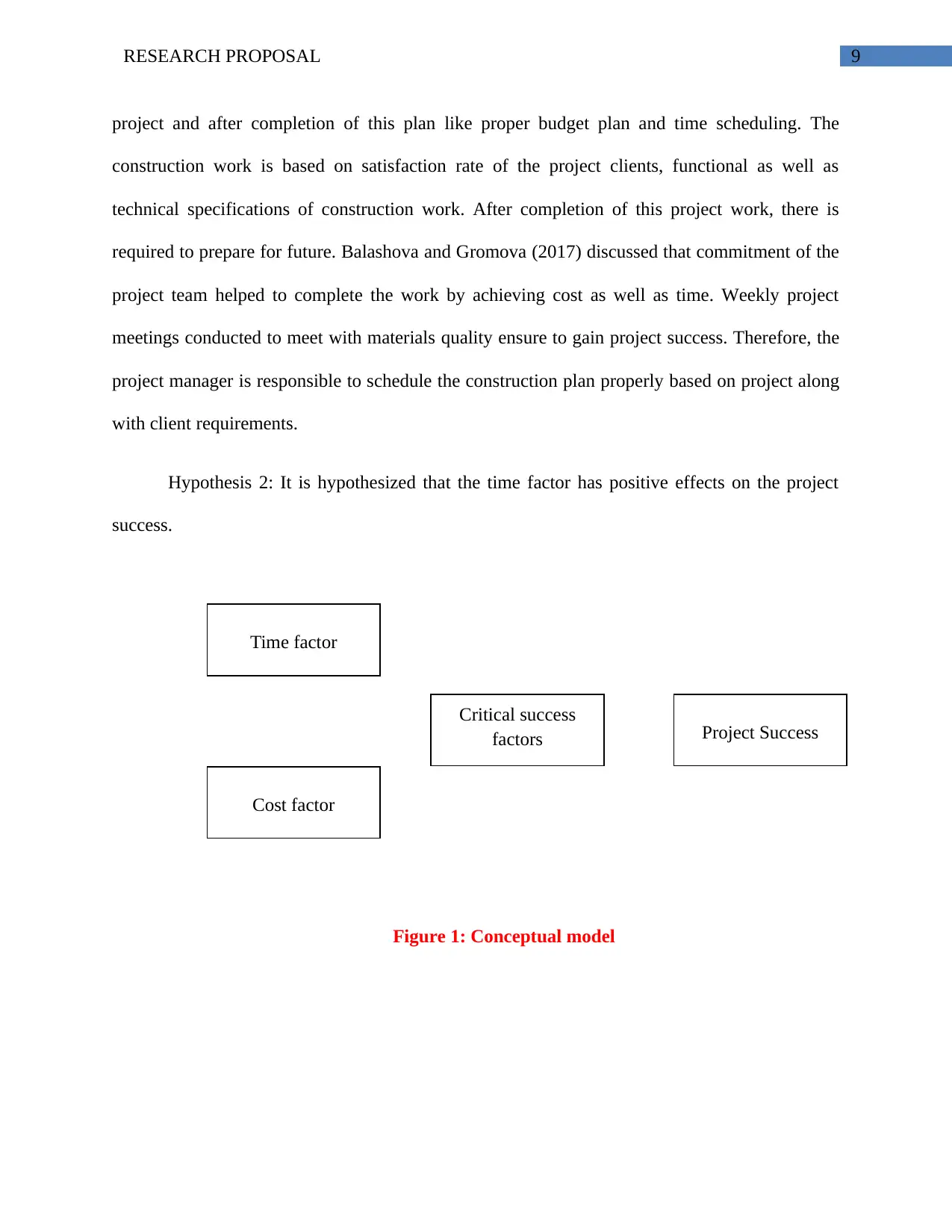
9RESEARCH PROPOSAL
project and after completion of this plan like proper budget plan and time scheduling. The
construction work is based on satisfaction rate of the project clients, functional as well as
technical specifications of construction work. After completion of this project work, there is
required to prepare for future. Balashova and Gromova (2017) discussed that commitment of the
project team helped to complete the work by achieving cost as well as time. Weekly project
meetings conducted to meet with materials quality ensure to gain project success. Therefore, the
project manager is responsible to schedule the construction plan properly based on project along
with client requirements.
Hypothesis 2: It is hypothesized that the time factor has positive effects on the project
success.
Figure 1: Conceptual model
Time factor
Cost factor
Critical success
factors Project Success
project and after completion of this plan like proper budget plan and time scheduling. The
construction work is based on satisfaction rate of the project clients, functional as well as
technical specifications of construction work. After completion of this project work, there is
required to prepare for future. Balashova and Gromova (2017) discussed that commitment of the
project team helped to complete the work by achieving cost as well as time. Weekly project
meetings conducted to meet with materials quality ensure to gain project success. Therefore, the
project manager is responsible to schedule the construction plan properly based on project along
with client requirements.
Hypothesis 2: It is hypothesized that the time factor has positive effects on the project
success.
Figure 1: Conceptual model
Time factor
Cost factor
Critical success
factors Project Success
Paraphrase This Document
Need a fresh take? Get an instant paraphrase of this document with our AI Paraphraser
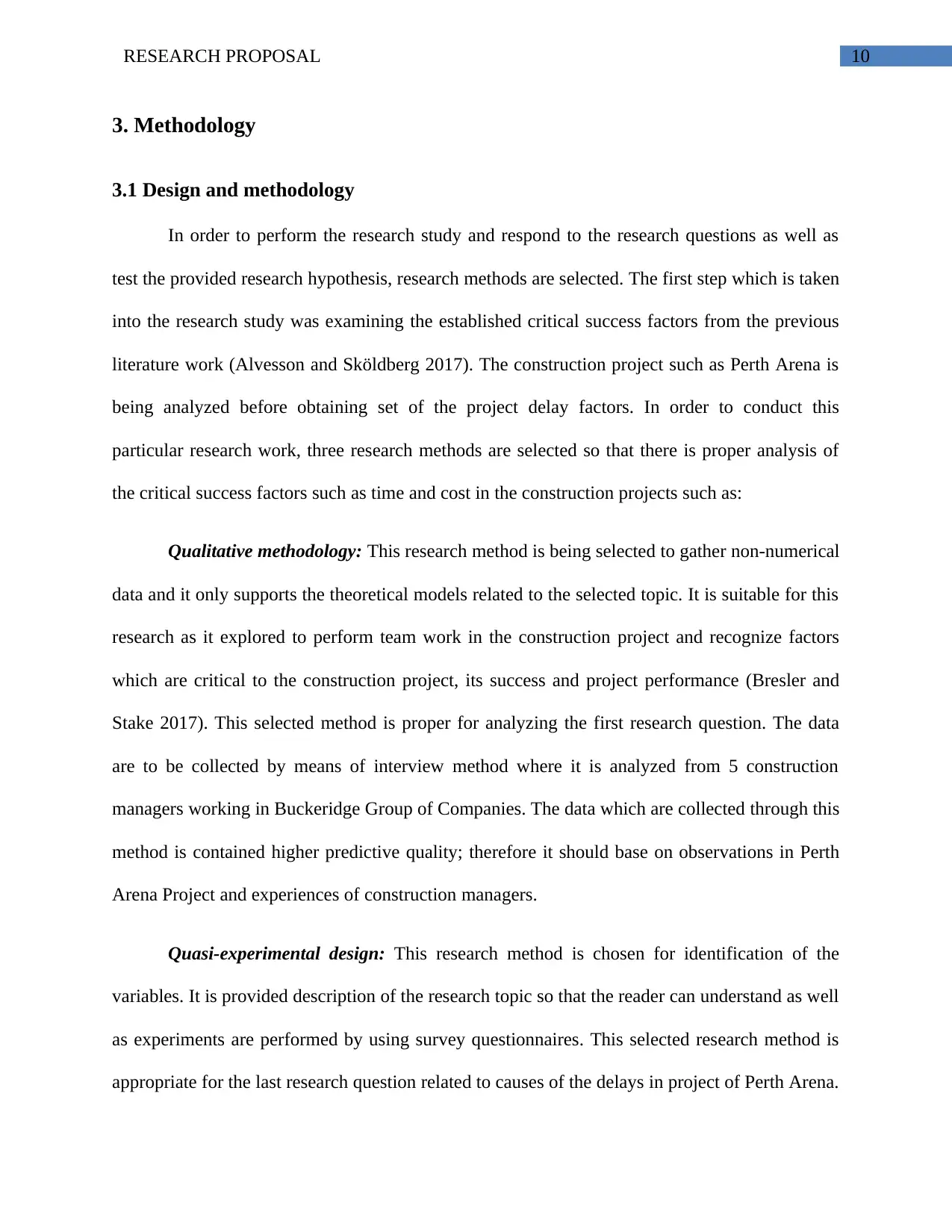
10RESEARCH PROPOSAL
3. Methodology
3.1 Design and methodology
In order to perform the research study and respond to the research questions as well as
test the provided research hypothesis, research methods are selected. The first step which is taken
into the research study was examining the established critical success factors from the previous
literature work (Alvesson and Sköldberg 2017). The construction project such as Perth Arena is
being analyzed before obtaining set of the project delay factors. In order to conduct this
particular research work, three research methods are selected so that there is proper analysis of
the critical success factors such as time and cost in the construction projects such as:
Qualitative methodology: This research method is being selected to gather non-numerical
data and it only supports the theoretical models related to the selected topic. It is suitable for this
research as it explored to perform team work in the construction project and recognize factors
which are critical to the construction project, its success and project performance (Bresler and
Stake 2017). This selected method is proper for analyzing the first research question. The data
are to be collected by means of interview method where it is analyzed from 5 construction
managers working in Buckeridge Group of Companies. The data which are collected through this
method is contained higher predictive quality; therefore it should base on observations in Perth
Arena Project and experiences of construction managers.
Quasi-experimental design: This research method is chosen for identification of the
variables. It is provided description of the research topic so that the reader can understand as well
as experiments are performed by using survey questionnaires. This selected research method is
appropriate for the last research question related to causes of the delays in project of Perth Arena.
3. Methodology
3.1 Design and methodology
In order to perform the research study and respond to the research questions as well as
test the provided research hypothesis, research methods are selected. The first step which is taken
into the research study was examining the established critical success factors from the previous
literature work (Alvesson and Sköldberg 2017). The construction project such as Perth Arena is
being analyzed before obtaining set of the project delay factors. In order to conduct this
particular research work, three research methods are selected so that there is proper analysis of
the critical success factors such as time and cost in the construction projects such as:
Qualitative methodology: This research method is being selected to gather non-numerical
data and it only supports the theoretical models related to the selected topic. It is suitable for this
research as it explored to perform team work in the construction project and recognize factors
which are critical to the construction project, its success and project performance (Bresler and
Stake 2017). This selected method is proper for analyzing the first research question. The data
are to be collected by means of interview method where it is analyzed from 5 construction
managers working in Buckeridge Group of Companies. The data which are collected through this
method is contained higher predictive quality; therefore it should base on observations in Perth
Arena Project and experiences of construction managers.
Quasi-experimental design: This research method is chosen for identification of the
variables. It is provided description of the research topic so that the reader can understand as well
as experiments are performed by using survey questionnaires. This selected research method is
appropriate for the last research question related to causes of the delays in project of Perth Arena.
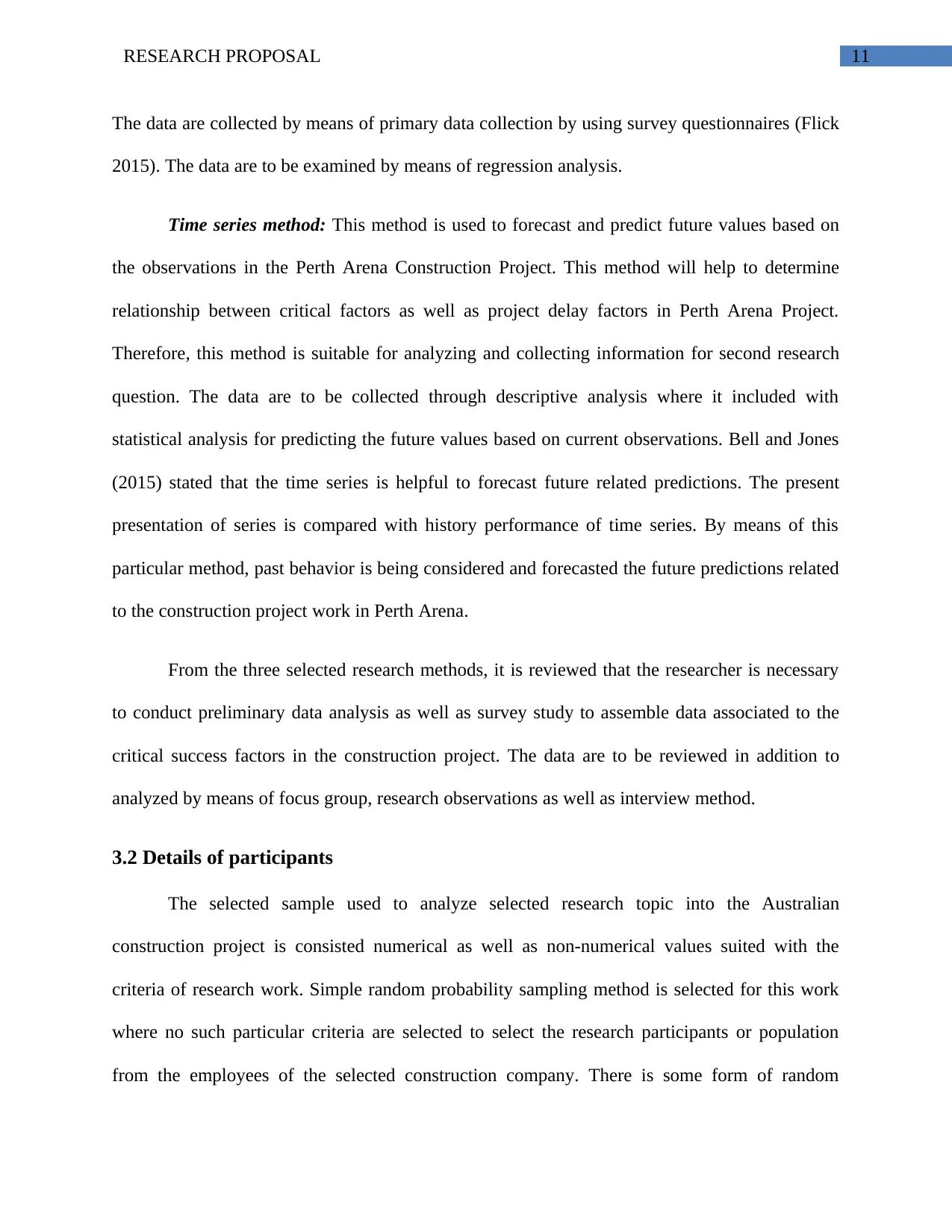
11RESEARCH PROPOSAL
The data are collected by means of primary data collection by using survey questionnaires (Flick
2015). The data are to be examined by means of regression analysis.
Time series method: This method is used to forecast and predict future values based on
the observations in the Perth Arena Construction Project. This method will help to determine
relationship between critical factors as well as project delay factors in Perth Arena Project.
Therefore, this method is suitable for analyzing and collecting information for second research
question. The data are to be collected through descriptive analysis where it included with
statistical analysis for predicting the future values based on current observations. Bell and Jones
(2015) stated that the time series is helpful to forecast future related predictions. The present
presentation of series is compared with history performance of time series. By means of this
particular method, past behavior is being considered and forecasted the future predictions related
to the construction project work in Perth Arena.
From the three selected research methods, it is reviewed that the researcher is necessary
to conduct preliminary data analysis as well as survey study to assemble data associated to the
critical success factors in the construction project. The data are to be reviewed in addition to
analyzed by means of focus group, research observations as well as interview method.
3.2 Details of participants
The selected sample used to analyze selected research topic into the Australian
construction project is consisted numerical as well as non-numerical values suited with the
criteria of research work. Simple random probability sampling method is selected for this work
where no such particular criteria are selected to select the research participants or population
from the employees of the selected construction company. There is some form of random
The data are collected by means of primary data collection by using survey questionnaires (Flick
2015). The data are to be examined by means of regression analysis.
Time series method: This method is used to forecast and predict future values based on
the observations in the Perth Arena Construction Project. This method will help to determine
relationship between critical factors as well as project delay factors in Perth Arena Project.
Therefore, this method is suitable for analyzing and collecting information for second research
question. The data are to be collected through descriptive analysis where it included with
statistical analysis for predicting the future values based on current observations. Bell and Jones
(2015) stated that the time series is helpful to forecast future related predictions. The present
presentation of series is compared with history performance of time series. By means of this
particular method, past behavior is being considered and forecasted the future predictions related
to the construction project work in Perth Arena.
From the three selected research methods, it is reviewed that the researcher is necessary
to conduct preliminary data analysis as well as survey study to assemble data associated to the
critical success factors in the construction project. The data are to be reviewed in addition to
analyzed by means of focus group, research observations as well as interview method.
3.2 Details of participants
The selected sample used to analyze selected research topic into the Australian
construction project is consisted numerical as well as non-numerical values suited with the
criteria of research work. Simple random probability sampling method is selected for this work
where no such particular criteria are selected to select the research participants or population
from the employees of the selected construction company. There is some form of random
⊘ This is a preview!⊘
Do you want full access?
Subscribe today to unlock all pages.

Trusted by 1+ million students worldwide
1 out of 27
Related Documents
Your All-in-One AI-Powered Toolkit for Academic Success.
+13062052269
info@desklib.com
Available 24*7 on WhatsApp / Email
![[object Object]](/_next/static/media/star-bottom.7253800d.svg)
Unlock your academic potential
Copyright © 2020–2025 A2Z Services. All Rights Reserved. Developed and managed by ZUCOL.


